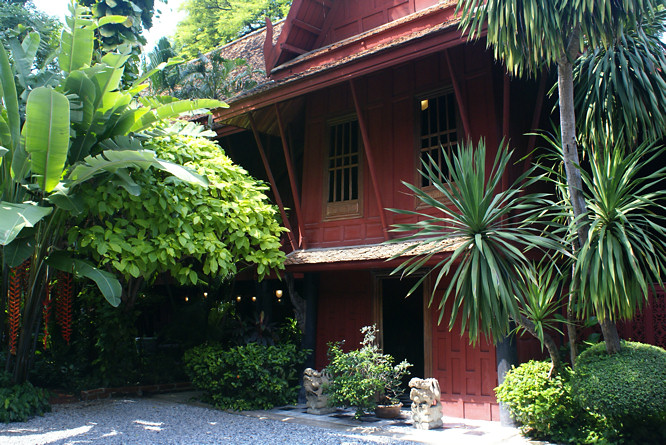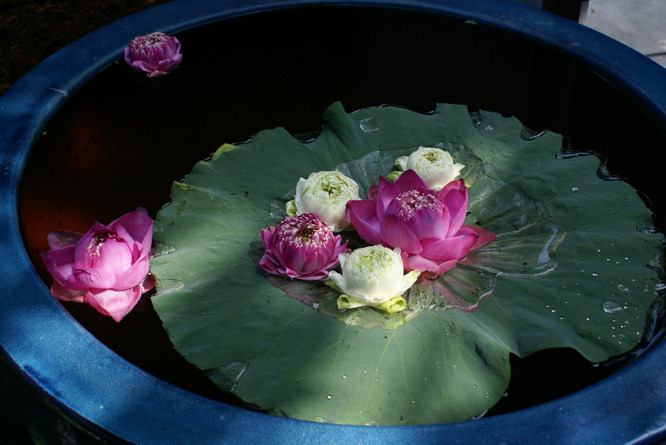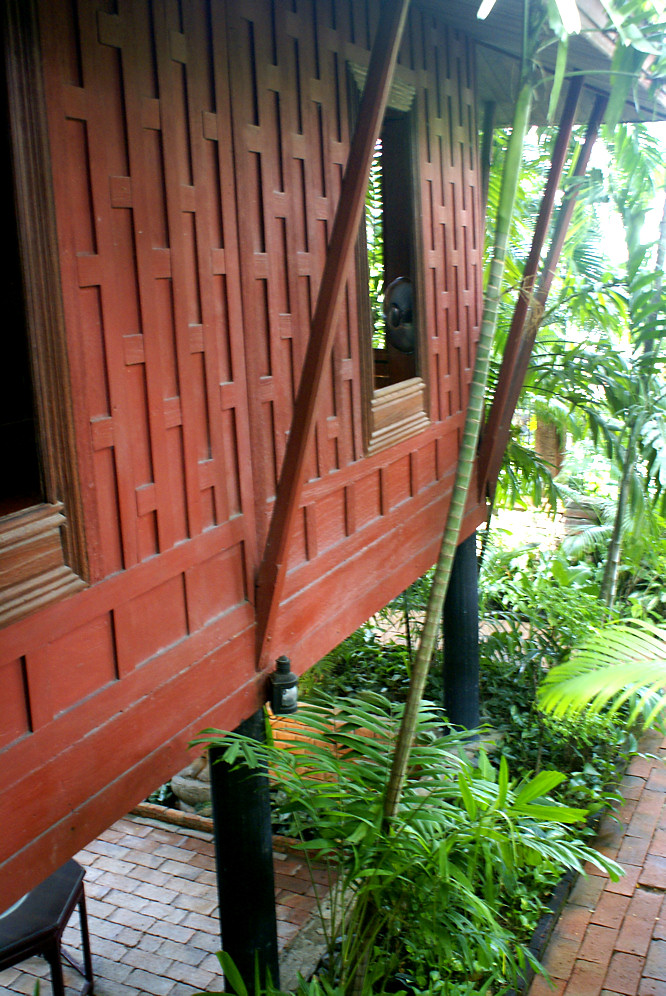Bangkok Jim Thompson House and Silk Museum
As a complete contrast to the madness of Bangkok city visit the tranquil Jim Thompson House museum. Jim Thompson was responsible for reinvigorating the Thai silk trade and making it a profitable industry which exported its fabulous fabrics all over the world.

He loved the beautiful traditional Thai architecture of teak built long houses with high pointed roofs on stilts. He 'collected' six and rebuilt them on his plot of land on the banks of the Saan Saab Canal, longest canal in Bangkok at 73 km.
What is not normal Thai practice is that he connected them all together to make one large house with lots of different rooms, where he could work, entertain and accommodate visitors. The house is set in a large lush tropical jungle garden.
Have a careful look at the angle of the sides of the houses. They are designed broader at the base and tapers towards the top. The doors and windows are similarly designed like this. The tapered structural features adds to the stability of the house and also to ventilation. This is very cleaver. The cool air is drawn in and hot air channeled upwards and out through the vents at the top of the walls.

A manual form of air-conditioning is thus employed without the use of any power. These Thai's know what they are doing. In a tropical climate metal will rust. No nails were used in the construction of these houses. To connect the wooden joints the craftsmen drill holes through both pieces of wood and then insert a wooden long round peg.
The house that was used as the living room is over 175 years old. It is the oldest house of the group. The other houses range between 75 to 150 years old. It took local craftsmen 11 months to complete to assemble all six houses. It must have been like assembling a giant IKEA flat pack without the instructions. Jim Thompson officially moved in on the 3rd April 1959. The date was chosen after careful consultation with astrologers in keeping with Thai tradition. In the study you will see an astrological card with this date on pasted on the wall.

The terrace at the front of the main house overlooks the boat landing. Beyond the garden wall flows the Saan Saab Canal with its busy riverboat traffic. Apart from looking very attractive Jim Thompson's tropical jungle garden has a practical application. It provides welcome shade on hot scorching days. The temperature difference creates local cooling breezes. Some of the trees in the garden are over 100-years. The thick green foliage that is interspersed between the wings of the house, almost obscures parts of the house from view. The trickling water features add to the peaceful atmosphere.
Jim Thompson was a collector of antiques and Thai handicraft. He has a number of Buddha statues ranging from 8th to 13th and 14th centuries dotted around the building. There are also displays cases of his collections of Chinese ceramics, Thai paintings and other antiques.
The story of the Jim Thompson - King of Silk
In Bangkok along the Saen Saab canal there was an established community of Cham Muslims who were Thai silk weavers. Bangkok had produced silk thread and fabrics for over 500 years. Because of the lack of demand this industry had declined. Jim Thompson loved the quality of their work and could see the potential profit if only he could create the demand and bring in orders. He ordered some hand woven Thai silk samples to be made so he could take them to potential buyers.
He went to the USA and convinced Vogue fashion magazine to publish an article, which took the fashion world by storm. Silk was now the hot fashionable fabric to wear and be seen wearing all over the world. The Jim Thompson Thai Silk Company was started in 1948 and the weaving of Thai silk commenced in earnest. He purchased some vacant land opposite the silk weavers. This is where he built his house.
Jim Thompson was an American spy. He was born in 1906 and became a qualified architect. In September 1945, just as World War II ended, he was posted to Bangkok as a member of the American OSS (Office of Strategic Services). This organization was the forerunner of the CIA. The Thai government was working with the Japanese. He had been trained to parachute into Thailand and link up with the Seri Thai the Free Thai underground to help prepare for the Allied invasion of Thailand by arranging acts of sabotage and providing information. This plan was changed because of the abrupt surrender of Japan after the dropping of the nuclear bomb on Hiroshima and Nagasaki. For a while he was the OSS station chief in Bangkok. After his military discharge he returned to Thailand to reestablish the US Embassy.
Jim Thompson lived in his house for eight years until 1967, when he disappeared mysteriously during a holiday in the Cameron Highlands in Malaysia.
Jim Thompson House - Opening hours and how to get there
The Jim Thompson House is open between 9am and 5pm every day. You have to go on a guided tour. The last guided tour is at 5pm. The entrance is on the Soi Kasemsan 2 road, a side street off the main Rama 1 road opposite the National Stadium. The easiest way to get there is by Tuk-tuk or taxi. The National Stadium skytrain station is nearby.
If you want a fun way to get to Jim Thompson House try the Bangkok Khlong Saen Saeb Canal Water bus. The nearest canal water bus stop is called Ban Krua Hua Pier. You walk about 100 meters down the side of the river to the Soi Kasemsan 2 road entrance. Just follow the signs.
The James H.W. Thompson Foundation
The James H.W. Thompson Foundation runs the Jim Thompson Museum complex. It is a non-profit organization and relies entirely on its own funding. The Jim Thompson House and Museum is now enjoyed by over 220,000 people each year with guided tours provided in Thai, English, Japanese, Chinese and French. The Foundation is committed to ensuring that future generations will also to be able to enjoy and appreciate the artistic and cultural legacy of Jim Thompson. Employing dedicated conservation professionals the Foundation also works closely with experienced restoration specialists as part of a comprehensive and ongoing conservation program for both the house itself and the collections contained within.
Guided by its founding principles of promoting awareness, understanding and appreciation of Thai art and culture, in 2003, The James H.W. Thompson Foundation further established the Jim Thompson Art Center to nurture artistic and creative activities focusing on both traditional and contemporary art, textiles and multi-disciplinary works within today's context. Over the past 12 years, the Art Center has organized more than 30 extensive exhibitions of contemporary and traditional art, conducted various educational programs and collaborated with many local and international art organizations to convene symposiums, seminars, workshops and special events.
Travel books

